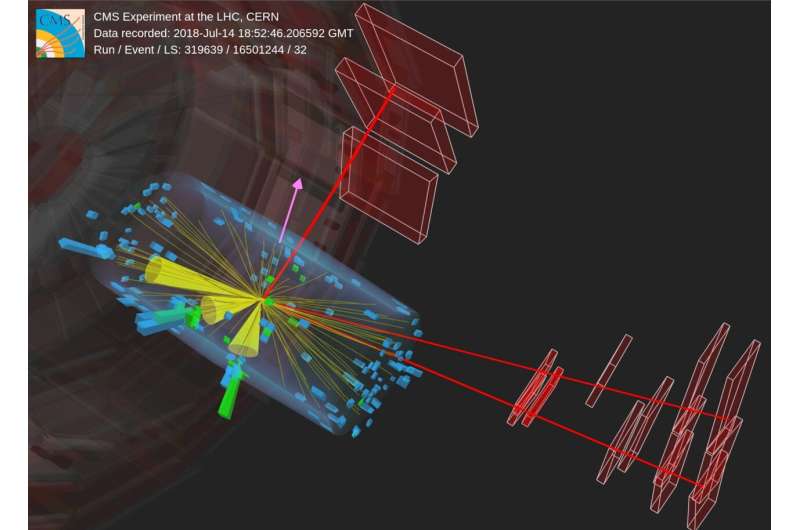Science
CERN Achieves First Observation of Single Top Quark Production

On November 3, 2025, researchers at the Large Hadron Collider (LHC) announced a groundbreaking discovery: the first observation of single top quark production alongside a W boson and a Z boson. This rare event, known as tWZ production, occurs approximately once every trillion proton collisions, marking a significant milestone in particle physics.
Unveiling the Complexities of Particle Interactions
The CMS collaboration at CERN has achieved this remarkable observation, which opens new avenues for researchers to explore fundamental forces of nature. The top quark, recognized as the heaviest known fundamental particle, interacts strongly with the Higgs field. Understanding how it engages with the electroweak force, mediated by the W and Z bosons, could provide deeper insights into the Higgs mechanism and potentially reveal new physics beyond the Standard Model.
Detecting tWZ production is a challenging task. The process is not only one of the rarest events that can currently be observed at the LHC, but it also closely resembles another event called ttZ production. In ttZ production, both a top quark and an anti-top quark are produced alongside a Z boson. This occurs approximately seven times more frequently than tWZ production, leading to significant background noise that scientists must navigate.
“The rarity of the tWZ process and its similarity to ttZ production necessitates sophisticated analysis techniques,” explains Alberto Belvedere, a researcher with the CMS collaboration at DESY. To differentiate the tWZ signal from background data, the team employed advanced machine learning algorithms, enhancing their ability to identify this elusive phenomenon.
Implications for Future Research
The recent findings, now available on the arXiv preprint server, indicate that the rate of tWZ production detected was slightly higher than theoretical predictions. This unexpected result prompts further investigation to determine whether it is merely a statistical anomaly or a potential indication of new interactions or particles.
“If unknown interactions are at play, the observed deviation in tWZ production rates would likely increase with higher energies of the outgoing particles,” notes Roman Kogler, another researcher with the CMS collaboration at DESY. Such an effect is particularly unique to the tWZ process, suggesting that the implications of this discovery could extend well beyond current understanding of particle physics.
The observation of single top quark production is a testament to the LHC’s capability to uncover some of nature’s most elusive secrets. As researchers continue to analyze data and refine their techniques, the potential for groundbreaking discoveries in the field of high-energy physics remains vast.
For further details, refer to the study titled “Observation of tWZ production at the CMS experiment” available on arXiv (2025), DOI: 10.48550/arxiv.2510.19080.
-

 Entertainment2 months ago
Entertainment2 months agoAnn Ming Reflects on ITV’s ‘I Fought the Law’ Drama
-

 Entertainment3 months ago
Entertainment3 months agoKate Garraway Sells £2 Million Home Amid Financial Struggles
-

 Health2 months ago
Health2 months agoKatie Price Faces New Health Concerns After Cancer Symptoms Resurface
-

 Entertainment2 months ago
Entertainment2 months agoCoronation Street’s Carl Webster Faces Trouble with New Affairs
-

 Entertainment2 months ago
Entertainment2 months agoWhere is Tinder Swindler Simon Leviev? Latest Updates Revealed
-

 Entertainment3 months ago
Entertainment3 months agoKim Cattrall Posts Cryptic Message After HBO’s Sequel Cancellation
-

 Entertainment2 months ago
Entertainment2 months agoOlivia Attwood Opens Up About Fallout with Former Best Friend
-

 Science2 weeks ago
Science2 weeks agoBrian Cox Addresses Claims of Alien Probe in 3I/ATLAS Discovery
-

 Entertainment3 months ago
Entertainment3 months agoMarkiplier Addresses AI Controversy During Livestream Response
-

 Entertainment2 months ago
Entertainment2 months agoMasterChef Faces Turmoil as Tom Kerridge Withdraws from Hosting Role
-

 Entertainment4 months ago
Entertainment4 months agoSpeculation Surrounds Home and Away as Cast Departures Mount
-

 World2 months ago
World2 months agoCole Palmer’s Mysterious Message to Kobbie Mainoo Sparks Speculation















